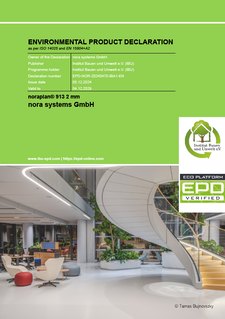Select a Location
It’s flooring—and then some. Made for More.
GET THE
COMPLETE
PICTURE
We were the first flooring manufacturer to publish Environmental Product Declarations (EPDs) for all standard products globally in 2012. Now, virtually all Interface standard products have a product-specific EPD.

WHY AN EPD MATTERS
Need credible information about a product’s life cycle? EPDs are the answer.
Think of them like a food nutrition label. But for a product’s environmental impact. Raw material extraction. Energy use. Emissions. Water use. Waste. EPDs cover all of these metrics and more.
So, what’s the most urgent data in an EPD? Global Warming Potential (GWP), a product’s carbon footprint. You can compare across products to understand the carbon impact of each. The lower the carbon footprint, the better for your project and the planet.
Tools like the Embodied Carbon in Construction Calculator (EC3) use EPD data. They make it easier than ever to select low-carbon products.
We use EPDs to disclose and reduce our impacts. This means our products can get you more LEED (Leadership in Energy and Environmental Design) credits. Which ones? Two common examples are the Building Product Disclosure and Optimization points for Environmental Product Declaration (option 1) and the LCA/Embodied Carbon Optimisation (option 2). Plus, there are several more.
EPDs require full disclosure of product information that is normally confidential. And a comprehensive life cycle assessment according to ISO 14040 and 14044 standards.
All EPDs align with ISO 14025 standards. Plus, both the EPD and the LCA are third-party verified.

EPDs FOR LVT










